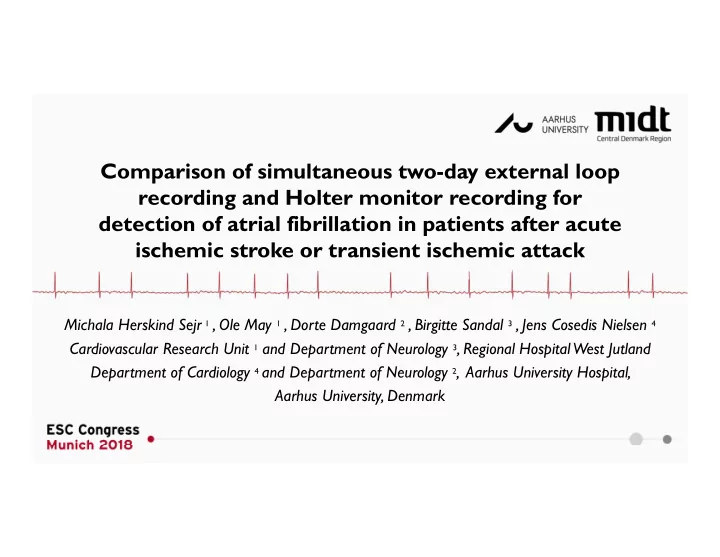

Comparison of simultaneous two-day external loop recording and Holter monitor recording for detection of atrial fibrillation in patients after acute ischemic stroke or transient ischemic attack Michala Herskind Sejr 1 , Ole May 1 , Dorte Damgaard 2 , Birgitte Sandal 3 , Jens Cosedis Nielsen 4 Cardiovascular Research Unit 1 and Department of Neurology 3 , Regional Hospital West Jutland Department of Cardiology 4 and Department of Neurology 2 , Aarhus University Hospital, Aarhus University, Denmark
Stroke and Atrial Fibrillation ~ 20% strokes are due to AF OAC reduces risk of stroke 60% in AF patients Short-term ECG recording + ECG ≥ 72 hours 30-day ECG monitoring of patients after stroke
Holter recording • Gold standard • 4 electrodes • 2-lead continuous ECG • Analysis is time consuming
External loop-recorder (ELR) • Up to 32-day monitoring • 2 electrodes • 1 lead short ECG recordings • Automatic AF detection
We aimed to determine sensitivity, specificity and positive predictive value of AF detection using two-day external loop recorder (ELR) monitoring against the gold standard of Holter recording
Methods and statistics ELR/Holter started simultaneously Endpoint: AF ≥ 30 sec. Holter as gold standard Blinded adjucation Exact McNemars test
Power Calculation • Assumptions: – ELR detects only AF also detected on Holter recording – Expected Holter detection of AF in 10% of patients – Holter recording detects 1.5% more patients with AF than ELR • Power and sample size: – Inclusion of 1,500 patients results in power of 83% to conclude that the true difference between recording methods is lower than 2.5% – Sample size calculation was based on 2-sided p-value of 0.05
Patient cohort TIA Ischemic stroke (n = 1,307) (n = 4,018) Patients excluded: Total Prior participation (n = 5,325) Known AF AF on 12-lead ECG Screened Holter after 1 week (n = 5,325) Low compliance Pacemaker Enrolled Active cancer (n = 1,507) Did not want to participate Completed two- Excluded: (n = 3,818) day ELR started Holter/ELR incorrectly (n = 1,412) (n = 95)
Population characteristics • Included June 2013 to December 2017 • Ischemic stroke / TIA within one week • Age ≥ 60 years • No prior AF or AF in 12-lead ECG Age 72.8 years (SD 7.8) 797 ♂ (56%) Ischemic stroke (60%) or TIA (40%) Hypertension 825 (58.4%) Diabetes 202 (14.3%)
Results AF in Holter No AF in Holter T otal AF detected by ELR 35 184 219 (15.5%) No AF detected by ELR 3 1,190 1193 T otal 38 (2.7%) 1,374 1,412 Sensitivity: 82.1% P-value=<0.0001 Specificity: 86.6% PPV: 16.1%
Results AF in Holter No AF in Holter T otal AF detected by ELR and 32 25 57 (4.0%) cardiologist verified No AF detected by ELR 6 1,349 1,355 T otal 38 (2.7%) 1,374 1,412 Sensitivity: 84.2% P-value=<0.001 Specificity: 98.2% PPV: 56.1%
AF detected by ELR, rejected by Holter
AF in Holter not automatically detected by ELR
Conclusions • Automatic ELR detection of AF results in an AF-diagnosis in more than 5 patients without AF for each patient with Holter-verified AF • Even after expert adjudication, sensitivity and positive predictive value of AF in ELR are modest to poor • False positive identification of AF potentially leads to overuse of OAC with increased risk of bleeding and of no benefit to the patient
Perspectives • Automatic ELR is not suitable for screening stroke patients for AF • This study calls for meticulous testing of new devices' ability to diagnose AF before they are taken into use
Thank you for your attention Funding Regional Hospital of Western Jutland • • Health Research Fund of Central Denmark Region • Danish Heart Foundation • Aase and Ejner Danielsen Foundation • Fam. Hede Nielsen Foundation Cabinetmaker Sophus Jacobsen and wife Foundation • • Aarhus University Travel Grant European Stroke Conference 2016 Travel Grant • • Danish Heart Foundation Travel Grant
Recommend
More recommend